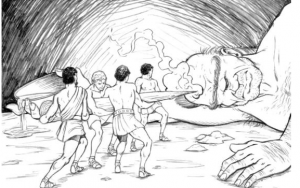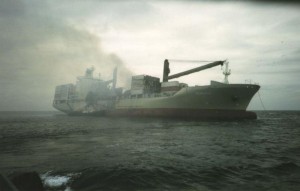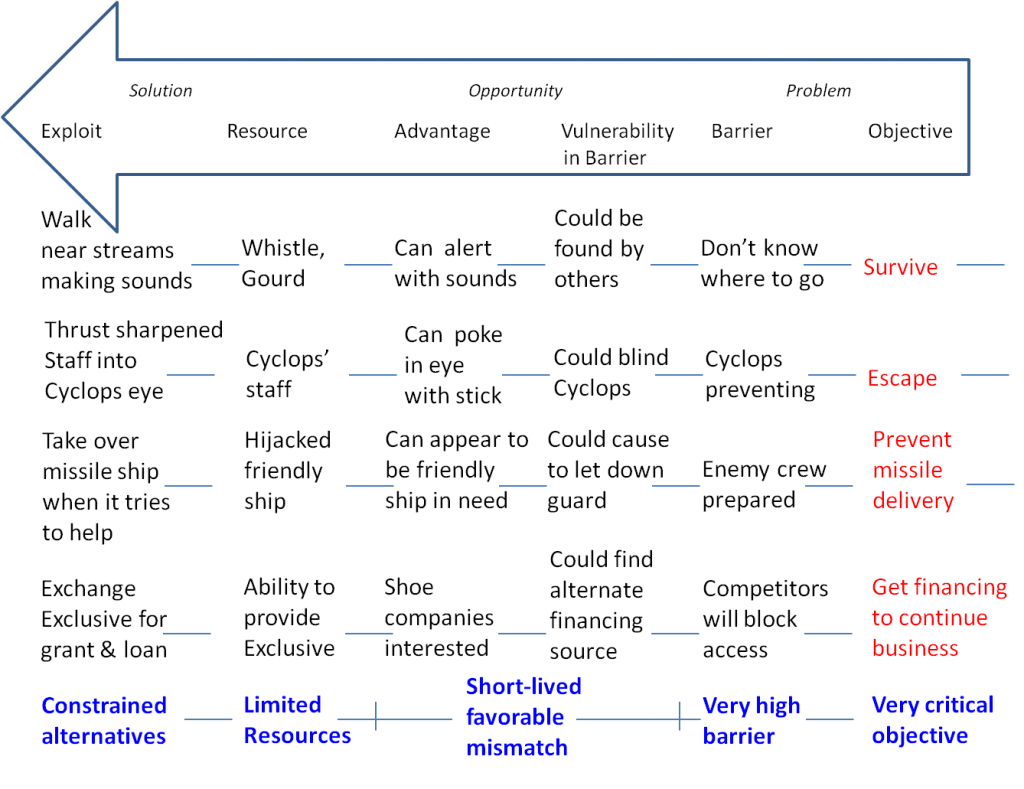LET’S take a quick look at some compelling strategy situations …
1. SURVIVAL
By a near miracle, or perhaps an actual miracle, you’ve just survived a night time airplane crash somewhere in the Amazon. The Amazon is a big place and you don’t know where you are. It’s also a formidable place, night or day. You probably wouldn’t last more than several days in this environment before perishing, so you have to quickly make your way to safety.
You sense that your chances of finding a village are poor and that perhaps you should try to arrange, instead, for someone else to find you. For example, native tribes-people. The vegetation is dense and sound doesn’t travel far, so shouting isn’t the answer.
You’ll have to make loud, penetrating sounds. You remember that in an elementary school music class program, a man taught the class how to make a shrill whistle from a reed. And you notice a dried gourd on a vine, that could be used to make a percussive instrument.
Since people tend to travel more by water than trail or road in the Amazon, you decide to move along waterways, blowing your whistle and beating your gourd strongly and rhythmically, to increase chances of the locals taking interest in the commotion. The noise may also keep potentially dangerous animals away.
At daybreak you set out as a one-man-band, causing a ruckus and creating a bow wave of riot among the birds and ground animals as you go. Before evening sets in a group of curious native hunters shows up to check out what’s going on. They recognize that you don’t quite belong there, and take you to their village where you can hop the next dugout canoe to a nearby settlement.
You’ve survived.
2. ESCAPE
On your way back from the Trojan War, you, your Captain Odysseus, and the rest of the crew become trapped in the cave of a one-eyed giant. The giant, Polyphemus, wastes no time signaling his intentions by straightaway devouring a couple of your fellow shipmates.
With their screams still echoing in your ears, you and your Captain Odysseus decide that your only chance to get away is first hide and then quickly arrange for escape, before Polyphemus can find you and invite you to dinner.
But it’s clear that Polyphemus has other ideas, and Job 1 is to ensure that the remaining crew aren’t spotted by him. If the Cyclops’ one eye could be blinded, then it would be possible to get out without his detecting anyone except with his hands. Of course, he might call on his Cyclops pals to come help – but that’s another problem.
While Polyphemus is tending his sheep, ever resourceful Odysseus finds a staff in the cave and hardens its tip in a fire. There’s the blinding weapon. Now, how to arrange to blind the giant and not become a morsel in the process?
Well, being Greek warriors, the crew would hardly be caught without wine – and they had brought some with them when they were checking out the cave. It could be used to make the Cyclops drunk and make him fall asleep.
When Polyphemus returns to the cave with his sheep, Odysseus steps out of hiding and offers him some wine, which is readily accepted. As you watch from your hiding place, the Cyclops becomes drunk and rather jocular, and asks Odysseus his name. The wily Odysseus answers “Nobody”, and Polyphemus eventually falls asleep.
You are among Odysseus’ hand-picked team that takes the red-hot poker and drives it into Polyphemus’ huge single eye while he slumbers, blinding him. He awakes shreiking, which draws his Cyclops neighbors, who ask what’s going on. He shouts “Nobody is killing me”, so naturally the neighbors don’t bother further, and leave.
When rosy-fingered dawn appears, the warriors cling to the bellies of the sheep as they leave the cave to graze, and you and the crew go undiscovered by the Cyclops. You’ve made your escape, and sail toward Ithaca on (of course) the wine-dark sea.
3. SPECIAL OPERATIONS (Spec Ops)
A ship owned by rogue state Moldova has departed from Odessa in the Ukraine and is taking long range missiles to Futurestan, a country that has recently demonstrated a nuclear capability. If the missiles are delivered, Futurestan will become a direct threat to several non-nuclear allies, as well as destabilizing the entire region and making a nuclear confrontation much more likely. The risks are unacceptable.
You are the commanding officer of a special operations unit that has been tasked with stopping the shipment. If not stopped, the ship should reach Futurestan within 13 days. Got to move quickly.
For a variety of reasons, you can’t just torpedo the ship. You’ll have to board and take control. The Moldovans and Futurestanis would be expecting to get intercepted if word of their shipment got leaked, so they’d definitely be prepared to repel such an attack from the sea or air. Boarding and taking over the ship would have to be done by stealth.
A quick intelligence analysis of other shipping in the area indicates that a second Moldovan-owned ship will be in the same waters as the first one in about 10 days. This gives you something to work with. It wouldn’t be expecting trouble. If you could raid that ship and take command before they could call for help, you could then create a ruse and draw the missile-bearing freighter, relatively nearby, into a trap.
You devise a strategy involving 3 ships. 1) the Moldovan missile freighter, 2) the 2nd Moldovan ship, and 3) a small registered freighter of your own that you will use in a couple of ways.
You first navigate nearby the 2nd Moldovan ship and request help with visual and audible signals (off the airwaves). You indicate to the Moldovan Captain that your crew is being affected by chemical fumes and that the ship needs to be immediately evacuated. Once on board, your special forces people quickly and quietly take over the Moldovan ship and sail on a course to take it near the Moldovan missile freighter.
A major fire on board the captured freighter is faked with fire pots and other incendiaries brought along for the purpose, and a distress call giving your Moldovan ship’s identity is radioed out. The missile freighter soon comes to the aid of its sister Moldovan ship.
Your own little freighter shows up and pretends to render aid, but moves in on the missile freighter, boards it and takes over.
The 2nd Moldovan ship takes on board the crew of the missile freighter and is then released to go on its way. The missile freighter, under your control, is escorted by your own little freighter, along with air cover, to the nearest naval base.
Mission accomplished.
4. STARTUP COMPANY
Your company, Stepergy, is introducing its first product and is depending on demonstrating a high volume of sales in the market in order to receive its next round of financing and be able to stay in business. This is a bet-your-business product introduction. It’s got to be successful.
The product is based on energy recovery from footsteps. You know the kid shoes that light up when the kid walks? Instead of powering an LED, this product recovers and stores the energy in electrical form from walking and running during the kids (and adults) waking hours. The device is then connected to a plug and transfers the electricity out onto the grid while the shoes aren’t being used.
It’s called AmpStep. The product is small and very light, comes in several attractive designs, and is attached to shoe lace holes so it can easily be used on whatever pair of shoes the owner is wearing at the time. The owner is given credit on his/her power bill for electricity pushed out onto the grid.
Several other companies have begun work on competitive products, but none so far have been able to come close to the energy recovery level of AmpStep’s. Nontheless they’re hot on your trail – and besides, you have bills to pay – so you have to move quickly.
Stepergy has rejected proposals to be bought out by the competitors, and the competitors can’t afford to be left out of the market. They’re large companies that have great influence over the distribution channels that you would need to use to reach high volume and would surely use that influence to block you.
How to keep from getting crushed by them? Well, who are the interested parties? Obviously Stepergy employees and obviously the competitors. And there’s the power companies. But Stepergy’s suppliers, and more importantly, their potential customers have a stake as well.
Your business model originally called for going through the distributor channel for its sales, at least initially. But in addition to its functional and style value for the consumer, AmpStep has high potential as a differentiator for a shoe company (“the first to offer this amazing new technology …”). In a search for potentially interested shoe companys, you find a medium-sized one serving the casual and sports markets with a popular brand, and wanting to do something disruptive to take market share away from the big boys.
After some exciting negotiations, you cut a deal in which the company, Sportiv, provides Stepergy with a substantial grant, together with a large low-interest loan. This is given in return for two-year exclusive access to the production of AmpStep products, which would be Sportiv-labeled and styled to Sportiv’s requirements.
This allows you to proceed with entry into the market with your revolutionary product, with built-in volume via Sportiv’s own distribution network, and financial coverage for the next two years, while Stepergy builds momentum to a point that it can stand on its own.
Just what you needed to keep the company alive .
Critical Operations Strategies
If you sense a parallel in the 4 strategies, it’s because they’re fundamentally so similar, as seen in the blue row at the bottom of the simplified strategy diagram below:
While the same elements of our different strategies differ from each other, they have the same characteristics: the objectives are all very critical, the barriers are all very high, the opportunities/favorable mismatches are all short-lived, etc.
This means they’re all the same Critical Operations type, and can be devised with the same sort of thinking and same sort of priorities – whatever the specifics of the situation. On the other hand, if we get into different circumstances, in which the characteristics of the elements are different, then naturally the type of strategy is going to be different, and we’ll want to approach it accordingly.*
From time to time we’ll take a look at other strategy situations and their types.
_________________________________________
*The General Strategy Model (GSM) that we’ve been working with throughout this blog provides the framework of strategy elements and external factors that allows us to recognize and see commonalities and differences in strategy types.
Readers are encouraged to add comments to this post.
And if you’d like to share or recommend the post, click on your preferred way in the left margin sidebar.
Stay tuned for the next post. If you’re not currently being automatically notified when new posts are published, then please Follow Real Strategy (top of right hand column on this page), and indicate how you’d prefer to be notified.
For other posts of interest, look in the Smart Menu.
Further reading on critical operations:
Survival: Deep Survival by Laurence Gonzales – an interesting and well-written discussion on survival, giving principals of survival for those accidently or intentionally putting themselves in harm’s way
Special Operations: Spec Ops by William H. McRaven – very readable and fascinating book of case studies and principles of special operations warfare by the chief of the U.S. Joint Special Operations Command (JSOC), overseeing activities such as the raid into Pakistan that took out Osama bin Laden
Photo credit: Surviving in the Jungle from http://www.jungleschool.com.my/survival.html
Image credit: Blinding the Cyclops from Scott English. See his site at http://www.scottenglish.wikispaces.com/The+Odyssey
Photo credit: Freighter on Fire from gccaptain. See his site at http://gcaptain.com/disaster-at-sea-photos-of-maritime-destruction/?282
Photo credit: Cutting the Deal from InfoBarrel. See their site at http://www.infobarrel.com/Startup_Business_Ideas_-_Promote_Your_Company











I like the parallelism between the four stories. This helps with understanding the elements. Note especially how ‘advantage’ always involves attracting, goading, proding.
[Translate]